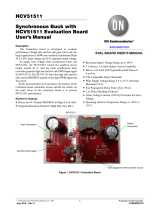
Evaluation Board User Guide
150V Half-Bridge Driver with Floating Grounds and Adjustable Dead-Time
One Analog Wa y, Wilmington, MA 01887 - 2356, U.S.A.
©2023 Analog Devic es, Inc. All rig hts reserved.
General Description
The EVAL-LTC7066-AZ evaluation circuit is a half-bridge
driver that drives two N-channel MOSFETs. The two 5V
logic-compatible PWM inputs independently drive each of
the two N-channel gate outputs to each MOSFET. The
eval kit has several unpopulated PCB pads to help
facilitate the user in customizing the board for their
application.
The LTC7066 driver has a powerful 0.8Ω pull-down and
1.5Ω pull-up MOSFET drivers driving two 150V N-channel
MOSFETs. The gate drivers on the LTC7066 are capable
of driving MOSFETs with different ground references;
however, this eval kit has these ground references
committed.
Design files for this circuit board are available.
Performance Summary (TA = 25°C)
Logic Input Supply (VIN-LOGIC)
Power Input Supply (VIN-POWER)
Maximum PWM Control Voltage
Quick Start Procedure
The EVAL-LTC7063-AZ can be evaluated without connecting any additional components or a load. However, the user
may find adding two load resistors, as shown in Figure 1, provides a better means for evaluating. Alternatively, the user
can configure their own application circuit. Test with a resistor divider as a load:
1. Connect two 100Ω power resistors to the SW node, as shown in Figure 1.
2. Apply VIN-POWER supply.
3. Apply VIN-LOGIC supply.
4. Apply two 5V, 1kHz square-wave signals 180° apart with a 48% duty cycle, as shown below. Limiting the duty
cycle to 48% and staggering them 180° apart will ensure no shoot-through.




